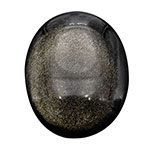Obsidian
Obsidian is a natural volcanic glass. It is not a mineral but a rock belonging to the rhyolites.
Obsidian is produced when lava with a very low content of water but rich in siliciumdioxide cools very fast, too fast in fact, to allow formation of crystalline structures. Thus obsidian is amorphous.
Origin of name: the name harks back to Pliny the Elder who in book 36, chapter 67 of his monumental compendium Naturalis Historia mentions Obsian glass and Obsian stone. Pliny describes it as "a substance very similar to the stone which Obsius discovered in
Æthiopia. This stone is of a very dark colour, and sometimes transparent...Many persons use it for jewellery..."
There is no other record of someone called Obsius apart from Pliny´s mention so it is impossible to determine who the man was.
Synonyms and trade names: there is a number of trade names referring to colour, origin or inclusions. Best known are Apache Tear, Mahogany Obsidian, Snowflake Obsidian, Rainbow Obsidian and Gold (Sheen) Obsidian.
A variety called Cali Glass after its source near the town of Cali in western Colombia was first described by Alexander von Humboldt is now mostly marketed as Columbianite.





Left to right: Apache Tear, Mahogany Obsidian, Snowflake Obsidian, Rainbow Obsidian and Gold Obsidian
Localities: obsidian is quite rare and mostly occurs in volcanically active regions. Important sources are Mexico, USA, Indonesia, Japan, Peru, Chile, Turkey, Armenia and Ethiopia. In Europe Obsidian is found in Iceland, Germany, Greece, Italy, Slovakia, Portugal (Azores) and Hungary.
Handling: obsidian is quite hard but also, being a glass, very brittle and splinters or breaks easily. Also, obsidian is sensitive to heat and to acids, in particular to hydrofluoric acid.
Worth knowing: obsidian forms extremely sharp edges when it breaks and was used for the production of tools like knives and scrapers and of weapons like arrow- and spearheads since Stone Age. The dreaded Maquahuitl, an Aztec wooden club with embedded blades of obsidian, had devastating effects in close-quarter combat. Spanish conquistadors reported that a well executed blow of a maquahuitl could sever a horsehead!
Polished obsidians were used as mirrors although Pliny writes "it is dull to the sight, and reflects, when attached as a
mirror to walls, the shadow of the object rather than the image."
 Deutsch
Deutsch